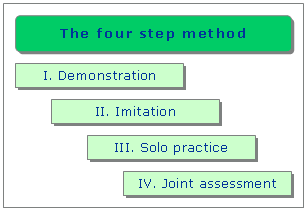Workplace instructions
Prior considerations on training at the workplace
The general preparation is outlined in the following steps, which can be determined by the next questions:
- To what end is the training?
→ the actual purpose of the work instructions should first be established.
- What should be learned?
→ the learning content should be defined out of the objectives of the instructions.
- How and with what media should the learning and teaching proceed?
→ the methodical procedure must afterwards be considered, based on the objectives and the content, i.e. how the learner and the trainer should work together to achieve the objectives. In a methodical procedure the use of learning and teaching material or media can be planned and recorded.
- Where and when should be learned?
→ Only after the objectives, content and methodical procedures have been established, should the questions of the organisation be addressed. Including the provision of the necessary work and support materials, the work and practice time and ensuring that the working environment complies with all industrial health and safety standards.
- How should it be supervised?
→ the last planning stage is the consideration of how the results of the exercise should be determined, assessed, and defined. Furthermore, provisions must be made for an eventual examination or certification.
The learning location is already determined in the workplace instruction. The same applies to the contents. During the implementation of the workplace instruction, the four-step method will be used, which is briefly described as follows:

I. Demonstration
The learning objectives and contents are explained to the learners before the exercise. Their prior knowledge must be taken into account to better meet their real needs. The learners must also be informed on the form of supervision or assessment, so that they can adjust to this and will not be surprised at the end of the exercise.
The exercise begins with the demonstration: at first, the complete operation to be learned is demonstrated at a suitable speed. After this, the complete operation is demonstrated slowly in partial steps/actions. The learners are asked to watch the operation carefully and to put questions if necessary. The learner and trainer/coach should ensure that each work step is explained and supported verbally. It is important not only to point out how one does it but also to justify why it is done in that way.The learner should, after several demonstrations, develop an internal script for the complete operation in order to be able to acquire the demanded skills with interest and high motivation.
II. Imitation
Under supervision and continuous observation the learner implements the operation and at first only takes care of the single work steps. The trainer does not interfere and only corrects the procedure, if it is not conforming to technical, health and safety guidelines. He/she makes no criticism or negative judgement. Recognition and praise however are definitely beneficial to this phase of learning. After repeating single, more complicated work steps, the learner should be asked to explain the single steps, as verbal support during the exercise renders the learning process more effective and improves the retention of information.
Finally, first the learners and then the trainer should repeat the complete operation once again as fluidly and comprehensively as possible. In this way the requisite standards of quality and quantity are stressed on the learners once more, before they go on to the unsupervised exercise.
III. Solo practice
The learners practice mainly independently and acquire the necessary skills directly in the activity at the workplace. They develop a sense of the pace of work, become more secure in handling the work utensils, recognise their own weak points by means of work, and begin to look autonomously for better ways to work, with less physical effort and more efficiency. The trainer must ensure, through occasional checks and supervision, that fundamental errors and lack of skills do not become fixed in the learners' practices. Once such mistakes may be difficult to adjust later. This phase is by far the longest and should take up about 70% of the allocatted time, while for each of the other phases 10% of the time should be enough.
IV. Joint assessment
All resulting learning performance should be evaluated. The development of vocational skills in the workplace instruction is central to the exercise so that the main emphasis of the evaluation also must lie on this. Each evaluation consists of two steps that must be clearly separated from each other.
- First, the objective of the workplace instruction is defined as exactly as possible;
- Secondly, evaluation in what extent what has been previously defined was achieved.
The assessment can be verbally conducted, documented or also kept in the form of notes. In general, no snap assessment is carried out during workplace instruction. The joint evaluation is however of high value which boosts self-confidence and induces improved performance. One learns at the same time to recognise the standards applied to vocational skills. Joint evaluation also enables the trainer to assess himself/herself and formulate an even more effective workplace instruction technique in the future.
Training measures in the enterprise ensure that primarily practical skills are acquired and learnt directly at the workplace. But one can not always implement the exercices in the real operating process. The particular features of the respective learning workplace must therefore also be taken into account. The exercises are only effective, if the trainer leads the learners systematically from the simple to the complicated, the easy to the difficult and slow to fast work and at first sets values on quality and not on quantity.
|
